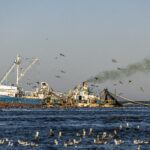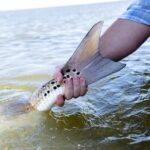
Gulf Menhaden Reduction Fishery: Bycatch Research & Useless Buffer Zones
Do you remember your driver’s test? How nervous were you when the instructor pulled out
Buried in the 2023 Striped Bass FMP Review are numbers that don’t add up—and it should infuriate recreational and commercial anglers from Virginia to Maine. While everyone else sacrifices to rebuild this fishery, Maryland’s commercial sector plays by its own rules, reporting data that defies logic and drags the entire coast down.
As part of our standard prep for the upcoming ASMFC meeting scheduled for the first week of August, the ASGA team is deep in the weeds. We’re attending Technical Committee and Plan Development Team meetings for redfish, menhaden, and striped bass. A big part of our process is poring over the documents: Fishery Management Plan (FMP) reviews, stock assessments, and datasets spanning decades. We look for patterns. We compare numbers. And in doing so, we have found some extremely concerning dynamics.
ASMFC and the Striped Bass Plan Review Team produced the 2023 Review of the Interstate Fishery Management Plan for striped bass in August 2024. The document is dense with data and trends that may seem benign to many. For us, it tells the story of a fishery on the path to repeating harrowing history. As a precursor, this case is a little “data dense,” but if you care about these fish and have been in the trenches of striper management in recent years, you need to know this…
The first thing that jumped out at us during the review is commercial dead discards—striped bass caught and killed but not sold or reported as harvested. According to page 25 of the 2023 FMP Review, the time-series average for commercial dead discards over the last 25 years is 20%, with certain years peaking over 30%. Yet in 2023, those discards are reported at a rate of only 2.8%! This rate should not pass the smell test. That’s a drastic reduction, and the numbers don’t hold up under scrutiny. If you want to follow along with the math, consult the FMP review by clicking here. Note that all page numbers correspond to the number at the bottom of each page, not the PDF file.
Take a look at 1997: (Table 3 on Page 25)
Now compare that to 2023:
Let’s put the significance of this rate into perspective. If that 20% average discard rate remained constant through 2023, that would change the total dead discard rate in 2023 from 16,965 fish to 120,000 fish! That is over 100,000 dead striped bass unaccounted for.
We questioned ASMFC staff about the extremely low discard number reported over the last two years. The explanation may be more concerning than the actual data. Tag returns determine commercial dead discards. In simplest terms, this discard rate is calculated using tagged fish that are landed and called in by any commercial fisherman in any commercial fishery. ASGA operates a coastal pelagics tagging program through the NOAA SE Science Center. We have had a wealth of tag returns in the first few years. Not a single tag has been called in by a commercial fisherman. We received a single call from someone who demanded a reward but refused to share the information. A recent study from Texas A&M implemented a high-reward tagging program for red snapper and found that incentives up to $500 per tag are required to get commercial fishermen to return tags. Even at that $500 rate, it did not ensure 100% compliance on returns.
ASMFC staff explained that there were not many tags called in for striped bass “because of years of poor recruitment and a lower abundance of small fish”, which they believe reflects a lower discard rate. You can imagine our bewilderment reading this statement after our campaign for a smaller slot limit in December 2024. ASGA proposed dropping the slot to reduce total fishing mortality by shifting away from our last healthy year class and towards weaker year classes. At the time, the campaign was met with resistance. We were told that a shorter slot would significantly expand harvest because of the abundance of smaller fish! So, which is it? Are there lots of small fish or none at all? How does striper data show that a shorter slot would increase harvest when commercial dead discards are down by 97% due to a lack of smaller fish, and that’s based on self-reporting tag returns? You can’t have it both ways. The issue with commercial data goes much deeper, so we shifted attention to the weight of commercial harvest.
This discard rate discovery drove us to look at the weight of commercial fish landed. As a reminder, striped bass are managed using the metric of “spawning stock biomass” (SSB). The SSB for this fishery is based on weight, so we’ll talk about weight. Commercial fishermen get paid by the pound, not the fish. That’s critical to remember.
For these calculations, let’s focus on Table 6, which documents poundage by states and Table 7, which shows total harvest in fish numbers. Checking this chart brought back memories from decades past, when there was a massive sting operation in Maryland because commercial operations were overestimating the number of fish caught while underreporting the total harvest weight. We will get into that a little later.
Some quick napkin math reveals that the average striped bass reported in Maryland’s commercial harvest for 2023 weighed just 4.63 pounds. That’s shockingly low. For context, the coastwide commercial average was 6.82 pounds, and in the ocean fisheries, the average fish weighed a staggering 16 pounds. Now consider this: Maryland and the broader Chesapeake Bay region account for approximately 80% of all commercially harvested striped bass by number. That means any irregularities or inconsistencies in their reporting can dramatically skew the data for the entire coast. Let’s take a closer look at Maryland’s regulations—and why these numbers don’t add up.
In any well-documented fishery, you’d expect the average weight of commercially harvested striped bass to increase as dominant year classes mature and move through the system. Consider the 2001 and 2011 year classes—both ranked among the top five strongest in recorded history. We can clearly see the impact of these cohorts in the recreational fishery as they grow within the ecosystem and drive corresponding spikes in harvest. In Maryland, recreational harvest jumped from 464,000 fish in 2002 to over 1.1 million by 2009, as the 2001 year class recruited to the SSB. So, what should we see in the commercial data during this time? A steady climb in average weight, especially considering that commercial sales in Maryland command a higher price per pound on the larger fish. Bigger fish can be sold for 20-30% more per pound, depending on the season. But that’s not what happened.
In 2002, the average weight of a commercially harvested striped bass in Maryland was just 3.08 pounds. By 2009—when those 2001 year class fish were seven years old and should have weighed well over 7 pounds—the reported average weight was only 3.7 pounds. That’s biologically and economically implausible. Why would an industry choose to harvest the least profitable fish at a time of such high abundance? This pattern repeats with the 2011 year class, the fourth strongest on record. In 2012, the average commercial fish weight was 4.0 pounds. Seven years later, in 2019, it had only increased to 4.13 pounds. That kind of stagnation defies everything we know about striped bass growth.
The Potomac River Fisheries Commission is a separate managing body for striped bass. While connected by water and sharing the same fish with Maryland, PRFC has its own quota and vote at the management level. These management jurisdictions are intertwined. “Young of the year” metrics for striped bass in Maryland are directly connected with PRFC. Their commercial regulations are very similar, with a single exception being there’s no maximum size in the Potomac after spawning season (though there are not many big fish around during the summer). In 2002, the average weight of a commercially harvested fish was 6.48lbs. In 2009 and 2012, the average fish was over 8lbs. In 2023, PRFC recorded an average of 6lbs. How can a fishery that shares the same fish record an average anywhere between 50-100% greater than another jurisdiction targetting the same fish?
These aren’t just data quirks. They suggest a serious reporting problem and a breakdown in how this fishery is being monitored and managed.
Most people don’t remember—or never knew—what happened in Maryland’s striped bass fishery in the early 2000s. But the scandal was nothing short of a masterclass in deception. A small group of commercial operators exploited weak oversight at weigh stations, submitting falsified permit cards that underreported the weight of their catch. Ten-pound fish were recorded as three- or five-pounders, allowing them to stay within their poundage quotas while dramatically exceeding their legal catch by number.
The fraud didn’t stop there. These same fishermen ran illegal gillnets overnight, using weighted nets to haul in fish during closed seasons. Undersized or excess fish were quietly discarded—mortality never logged—keeping discard rates artificially low and escaping regulatory scrutiny. From there, untagged fish were funneled through a network of complicit dealers, transported across state lines to New York, Pennsylvania, and Delaware. It was a laundering operation for poached striped bass—profiting off a stock that was still recovering and meant to be protected.
The deception ran deeper than just forged numbers and illegal nets. Intimidation tactics were used to silence potential whistleblowers, keeping the operation under wraps while profiteers took full advantage of the booming post-moratorium demand for striped bass. The commercial striper industry manipulated data at every turn—fish counts overstated, weightsunderstated and discards ignored. The result? Skewed stock assessments that delayed meaningful regulatory action and prolonged the fishery’s vulnerability during a critical recovery period. This scheme was more than a loophole. It was multi-layered fraud, uncovered only through undercover operations, seized gear, and years of investigative work. When enforcement cracked down in 2003, the scheme had turned a recovering, regulated resource into a black-market goldmine. If you would like a few examples, look into the operation busted in 2009, resulting in multiple federal Lacey Act violations or the Kent Island gill net poaching ring busted in 2011.
Let’s break it down. According to ASMFC’s charts, the coastwide commercial striped bass harvest in 2023 was just over 4 million pounds. That number is built on two shaky pillars:
The implications are massive if either of those numbers are off by even a little. Let’s run the math:
For years, the commercial sector has hid behind the statement “we’re only 10% of harvest” to avoid accountability in rebuilding this fishery. Remember, this fishery is managed for SSB, which is based on weight. Even before any of these “commercial accounting errors”, commercial fishing is actually 15% of harvest by weight. Now, incorporate the discard rate adjustments we just discussed, along with the fact that the FES Survey found that recreational effort may be overestimated by up to 30%, and suddenly, the whole landscape changes. The “little harmless commercial sector sitting on the sidelines” is likely closer to 30-40%+ of total harvest. If so, the Striped Bass Board allowing the sector to largely not participate in the conservation of this resource is despicable.
This math isn’t speculation. It happened during the striped bass fraud scandal in Maryland two decades ago. And still today, in the very same state, we see fyke nets, trot lines, and jug lines working the spawning tributaries—while recreational anglers are banned from even catch-and-release fishing during that same window. You don’t think there are dead discards from that gear? Think again. Here’s a photo of a fyke net that broke loose in the Upper Bay this spring. This net is not intended for striped bass, yet it is packed with them during a recreational closure.
We have to ask: Does anyone seriously believe that the release mortality of recreational anglers is killing fish at three times the rate of the commercial fleet discards?
Because that’s what the numbers say. According to ASMFC’s own review, recreational release mortality is pegged at 9%, while commercial dead discards are listed at just 2.8%. We’re talking about a recreational sector not allowed to fish for extended periods, using circle hooks with growing educational campaigns, facing strict slot limits and decreasing participation in Maryland waters. Yet, during those same closure windows, the commercial side uses trot lines, jugs and fyke nets to “target other species” in the spawning rivers – and somehow reports a fraction of the release mortality? It doesn’t add up.
How does this make it past the ASMFC Striped Bass Technical Committee? If the data is this transparent to the public—and if we know the history of enforcement failures, fraud, and underreporting—why isn’t this setting off alarm bells inside the system?
Maryland is destroying a multibillion-dollar fishery that belongs to every recreational and commercial fisherman on the Atlantic coast.

Do you remember your driver’s test? How nervous were you when the instructor pulled out

If you’ve spent any time on the water in South Florida, chances are you’ve heard

Photo Credit: Graham Tayloe Big Win for Redfish in Alabama Huge news from the Marine

Feature Photo: Carter Abramson | Simms Fishing at the Fisheries Science Symposium We have more
We rely on our members and donations to keep fighting for a sustainable tomorrow in marine conservation.
GIVE THE GIFT OF FISHERIES CONSERVATION THIS HOLIDAY SEASON. SHOP ASGA GOODS THAT FUND FISHERIES RESEARCH & ADVOCACY CAMPAIGNS
JOIN ASGA IN CALLING FOR CRITICAL MANAGEMENT ACTION AFTER YEARS OF SPAWN FAILURES & POOR MANAGEMENT.
By using this website, you agree to our use of cookies. We use cookies to provide you with a great experience and to help our website run effectively. To learn more, please review our privacy policy.